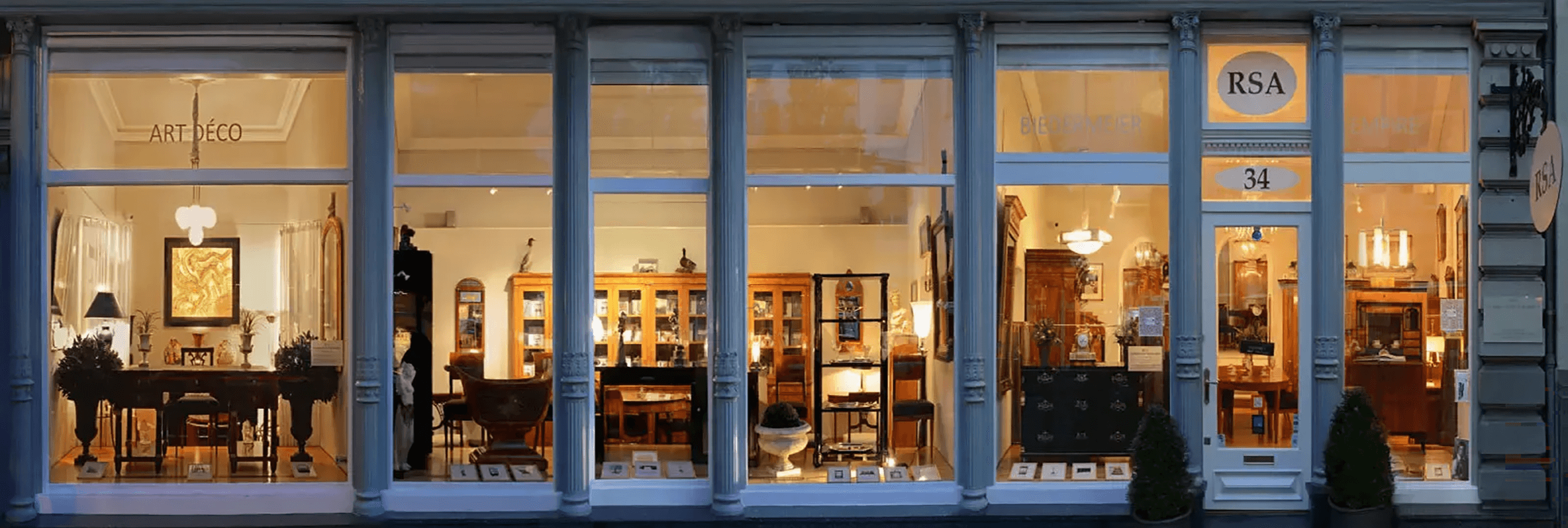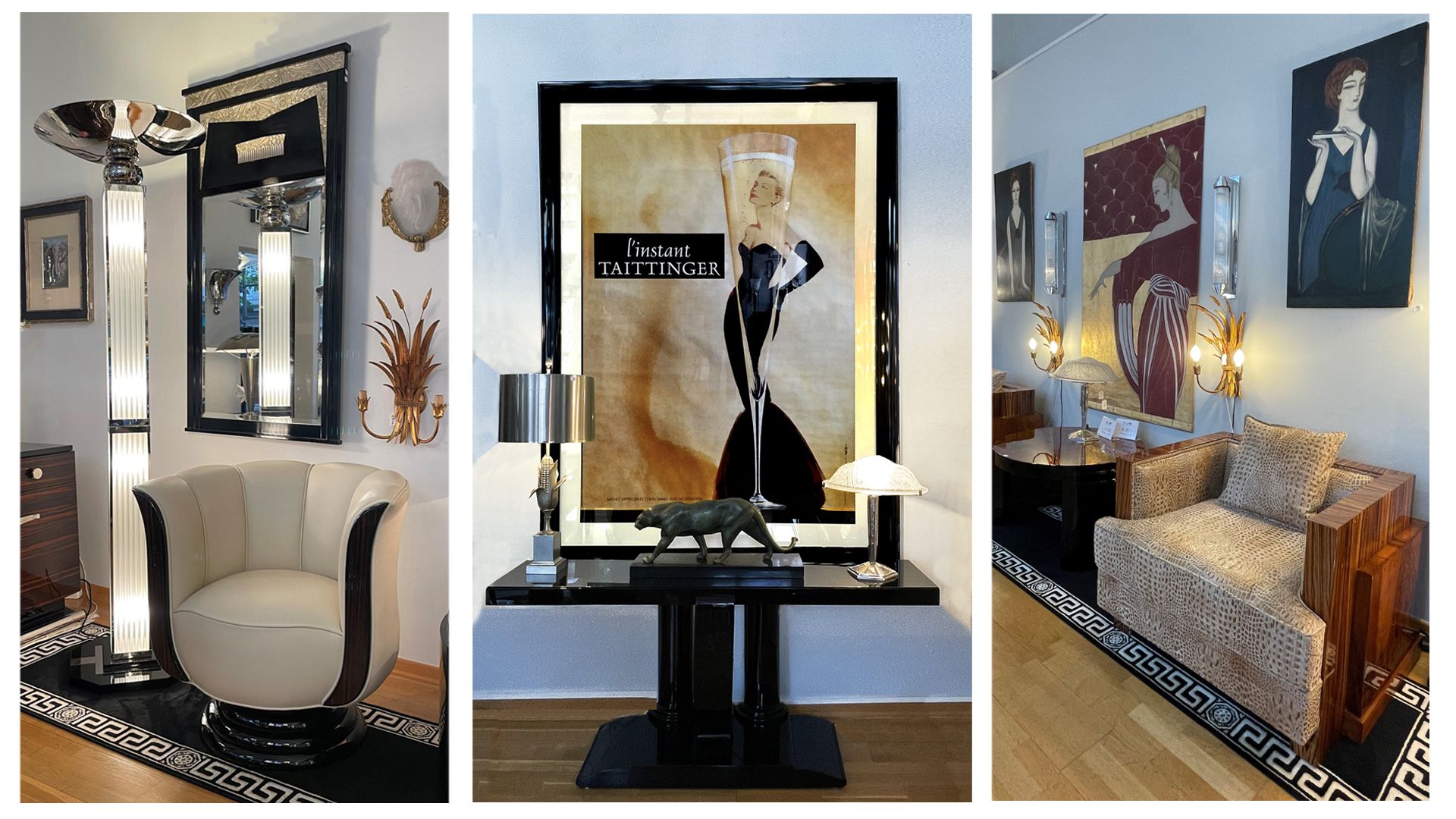Art Deco Furniture and interiors
Antiquitäten Wiesbaden specialises in Art Deco furniture and objets d’art from France from around 1930.
All objects are listed with descriptions and prices.
Regine Schmitz-Avila has been an art dealer for more than 40 years.
Her shop at Taunusstrasse 34 in the heart of the state capital Wiesbaden has been recognised as one of the best antique shops in Germany by the trade magazine Architektur und Wohnen.
Sustainability in the antiques trade
In the world of the antiques trade, history and craftsmanship are closely interwoven.
Conservation and restoration are at the heart of the antiques trade, especially when it comes to furniture.
The historical surface and its historical significance preserve the value and authenticity of the furniture.
In today’s age of transformation, sustainability plays an enormously important role.
Resources must be used in an environmentally conscious manner and the reuse of furniture and artefacts promotes sustainability immensely.
Therefore, with every antique purchase you ensure the longevity of these precious works of art and preserve the cultural heritage of our world.
Original Art Déco, Biedermeier and Antique furniture at RSA Antiquitaeten Wiesbaden .
RSA Antiquitäten Wiesbaden is your antiques dealer in the Rhine-Main area. At RSA Antiquitäten Wiesbaden you can expect a large selection of antiques from the Biedermeier, Art Deco and Design eras. RSA Antiquitäten Wiesbaden is the leading specialist store for high-quality German and French furniture and interior design from the eras between 1820 and 1970. Our customers appreciate the special elegance of Art Deco furniture, lamps, mirrors and bronzes. With the high quality of our objects, we have established ourselves as a leading art dealer since 2000
Art Déco and Biedermeier Furniture in Wiesbaden
In our renowned shop, which is located in a neoclassical building on Taunusstrasse, one of the most beautiful addresses in the heart of the Hessian state capital Wiesbaden, we present our customers high-quality furniture in its most beautiful and varied form on around 330 square meters of exhibition space. In addition to a stylish presentation of our exclusive antiques, we pay particular attention to on-site furnishing advice.









We will be happy to advise you!
Do you have questions about the services of our consulting company?
Would you like a direct conversation? Use our callback form or send us an e-mail with your request.

Biedermeier – furniture
In contrast to the pompously ornamented emphasis on the powerful and elemental in the formal language of the Baroque, Biedermeier furniture – see the Biedermeier cabinets in our portfolio – reflects an understanding of design and art that is expressed in emphatically matter-of-fact stylistic designs; clear forms and bright, sometimes contrasting colors are preferred. The extensive absence of surface decorations is an expression of this sparse aesthetic, as is the fact that predominantly domestic woods are used in the manufacturing process. This “style of simplicity” develops in the course of the epoch into the ideal of a modesty that can be interpreted as a deliberate turning away from the luxurious pomp of the 18th century (see Frankfurt cabinet and tabernacle secretary): The contemporary virtues of bourgeois inwardness receive their aesthetic counterpart in simple elegance and functionality. The Biedermeier period is closely associated with
the social rise of the bourgeoisie after the Congress of Vienna (1815). However, it is by no means an art that had only bourgeois clients. Some of the most remarkable, but also simplest pieces of furniture were commissioned by the court and the nobility. RSA Antiquitäten Wiesbaden offers its customers a generous selection of outstanding Biedermeier exhibits – chests of drawers, Biedermeier pull-out tables with matching chairs, seating furniture, mirrors and tables, as well as paintings and various accessories from the period between 1815 and 1848.

Clarity and elegance: between Art Déco and Biedermeier furniture (cabinets, chests of drawers, tables and chairs, etc.)
While Baroque furniture displays a representative, powerful and opulent formal language, Art Déco furniture or Biedermeier (chests of drawers, cabinets, secretaries, etc.) are associated with a rather clear, yet timelessly elegant aesthetic. A special example of the baroque style is the two-door Frankfurt cabinet with its magnificent dimensions and a characteristically protruding cornice, for which you can find some outstanding exhibits in our portfolio. In contrast, the Biedermeier period at the beginning of industrial and technical development in Germany focuses on rather simple and restrained expressive elements and a clear formal language. Some 70 years later, moments of that formal rigor can be found in the design style of Art Déco, which combines the simple character with a contemporary sleek elegance and sophistication, as we see in the arts and crafts: Furniture (Art Déco chairs, tables, lamps, etc.), jewelry, textiles, ceramics or interior design of the 20s and 30s.

Baroque showpiece: The Frankfurt cabinet
The so-called “Frankfurt wardrobe” is an exceptional example of a Baroque – furniture, which reminds us of the master craftsmanship of the carpenters’ guild from the Frankfurt area in the period of the 18th century. In our portfolio we carry some of these magnificent closets, which were once used to store household linen and clothes in patrician houses and bourgeois households. In contrast to Biedermeier furniture, which seeks to harmonize restrained form and functionality, the Frankfurt wardrobe served, among other things, representation in its material quality, craftsmanship and size, which allowed conclusions to be drawn about the social status of the owner. In addition to these showpieces, our spacious showrooms present a constantly changing selection of unique historical furniture, from Art Déco mirrors to tabernacle secretaries. Everyone interested in art and furniture is welcome here, we value exchange and conversation.

Antiques in their exclusive diversity:
From the Tabernacle Secretary to the Art Déco Chair
Lovers of artfully crafted Baroque furniture will feel just as much at home with us as art lovers of Art Déco furniture design (chairs, tables, seating furniture or mirrors, etc.). We would like to offer you the whole spectrum of our antiques in their unique variety. Whether you are interested in an extraordinary rarity such as a so-called “Tabernacle Secretary” (Baroque), or rather enjoy one of our Empire chests of drawers – we will be happy to advise you in our showrooms and give you valuable advice on how to integrate your historical treasures appropriately and stylishly into your modern living ambience.
Antiques Wiesbaden in the Rhine Main area
The Frankfurt Rhine-Main region accounts for 7.9% of Germany’s gross value added. The part of the region belonging to Hesse even generates 78% of Hesse’s gross domestic product. These figures emphasise Frankfurt Rhine-Main’s position as one of the most important metropolitan regions in Germany by European standards.
Banks and investment companies as well as the European Central Bank are predominant in Frankfurt city centre. The chemical industry has been based in the region for a long time, particularly in the Höchst Industrial Park. Other services have established themselves in the wider area, with the automotive industry playing a key role. Many of these have European or German headquarters, often with research and design centres. The construction and property industry is also one of the region’s economic heavyweights, accounting for 18% of regional gross value added.[13] Darmstadt and Wiesbaden have established themselves as science cities, home to federal authorities and insurance companies.
The logistics sector is particularly favoured by Frankfurt Main Airport and the central connection to the motorway and railway network. The Frankfurt motorway junction and Frankfurt Central Station are the busiest in Europe. Munich, Hamburg, the Benelux countries, Paris, Switzerland, Austria, the Czech Republic, Poland and Berlin can be reached within a few hours’ drive. Other important long-distance railway stations are Mainz Hbf, Frankfurt Süd and Frankfurt Flughafen Fernbahnhof. Frankfurt Airport offers direct flights to many destinations worldwide. The infrastructure in the Rhine-Main region is considered to be very well developed.
The city of Wiesbaden has excellent connections to Frankfurt am Main and offers various transport options for commuting between the two cities. Here are some of the most important means of transport and connections:
Car: The A66 motorway connects Wiesbaden and Frankfurt directly. The journey time between the two cities is usually around 30 to 40 minutes, depending on traffic and exact location. Note, however, that there can be traffic congestion at peak times.
S-Bahn: The S-Bahn network in the Rhine-Main region offers a fast and efficient connection between Wiesbaden and Frankfurt. The S1 line (Rhein-Main S-Bahn) runs from Wiesbaden Central Station to Frankfurt Central Station and stops at various stations along the way, including Mainz and Frankfurt Airport. The journey time is around 30 to 45 minutes, depending on the exact connection.
Regional trains: In addition to the S-Bahn trains, regional trains also run between Wiesbaden and Frankfurt. These offer an additional option for those wishing to commute between the two cities.
Buses: There are also bus connections between Wiesbaden and Frankfurt. These can take different lengths of time depending on the route and traffic conditions.
Bike: For those who enjoy cycling, there are also cycle paths between Wiesbaden and Frankfurt. This option is environmentally friendly, but requires more time and effort than other modes of transport.
Frankfurt Airport: Frankfurt am Main Airport is one of the largest international airports in Europe and is located close to Frankfurt. It also provides an important connection between Wiesbaden and other destinations worldwide.
The connection between Wiesbaden and Frankfurt is well developed and you have the option of choosing the right mode of transport depending on your preferences and needs. The S-Bahn is often the preferred choice for commuters as it provides a fast and reliable connection between the two cities.

-
RSA Antiquitäten Wiesbaden
-
Taunusstraße 34
65183 Wiesbaden -
+49 611 5 29 05 70
-
+49 170 7 83 01 13
-
info@antiquitaeten-wiesbaden.de
-
Mondayclosed
-
Tuesday - Friday12 a.m. - 6 p.m.
-
Saturday10 a.m. - 4 p.m.






